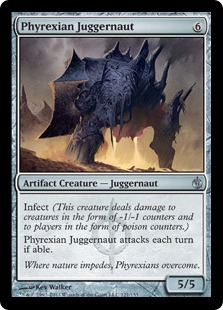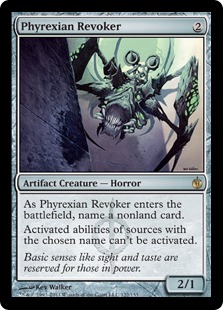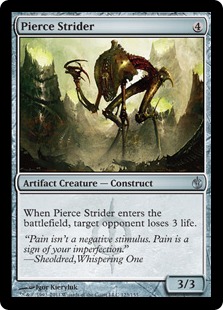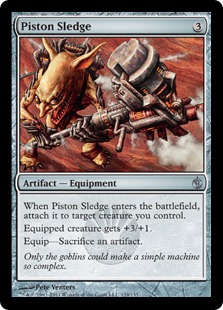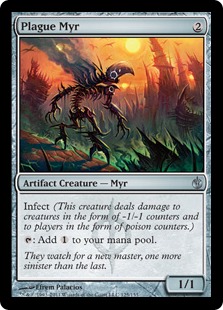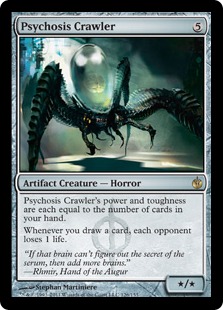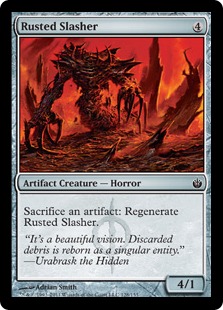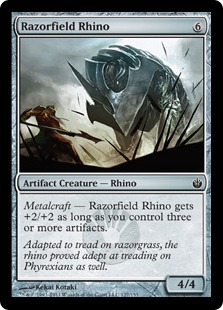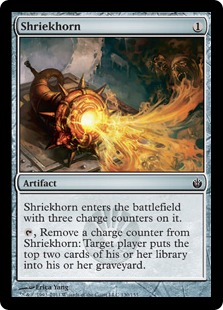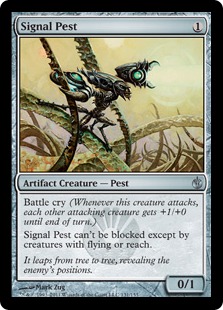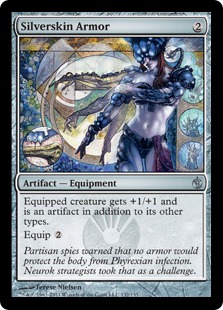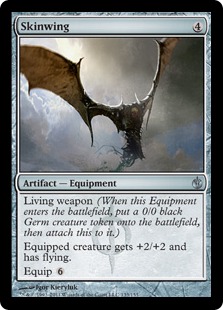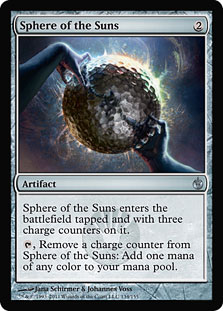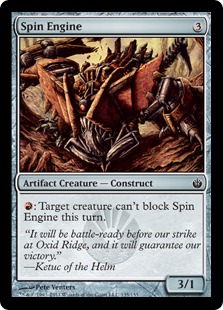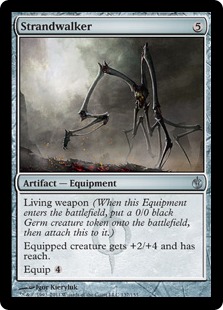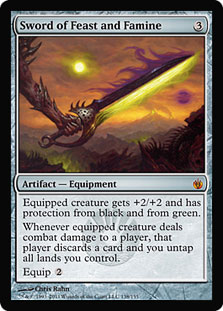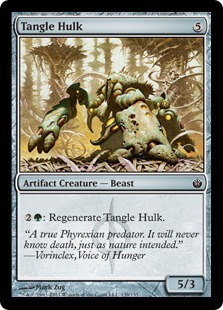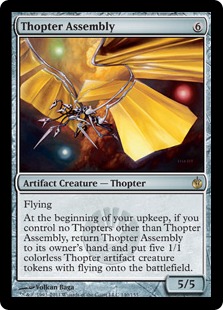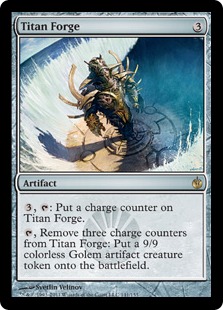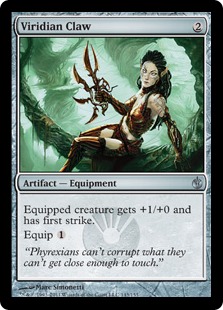Welcome to day three of my examination of Mirrodin Besieged. As in part one and part two,
we’ll be focusing on how we might use every card and what it would take to make each card worth considering, rather than using some arbitrary number
rating. A far more important rating, in my opinion, is whether a card is format defining, a flagship that makes a new archetype possible, a staple, a
role-player, fringe, or actually unplayable (which I generally only give to fairly vanilla cards that are just worse versions of other bad cards and
would take a very strange card being printed to make them playable). Â
Some people would consider this a 0-5 scale, but sometimes the role-players are better than the staples, and sometimes both are better than the
flagships. Cards change in value so much contextually that one has to ask, what does a numerical value of 0-5 or 1-5 even mean? If each number is
divided into percentiles or even if we have a curve where there are only X number of 5’s, Y number of 4’s and so on, what’s the point? What does that
tell us? Â
Other people just have a sentence that describes what a 5 is, what a 4 is, and so on, but in that system, why the artificial and somewhat misleading
numerical symbol? The truth is that a number rating is the simplest way to try to sum up a card, making it very easy to look at the whole set and
decide which bunch of cards to dismiss as well as which bunch of cards to focus on. That’s certainly reasonable, as many people just want to get a
general feeling of how much other players like a card. It is, however, exactly how most people end up focusing on the same, often obvious cards, as
well as dismissing a lot of cards that actually have hidden potential. How “good” the cards will be is entirely a function of context, and
understanding each card is far more useful than making it easy to tell ourselves these 20 cards are the “most obviously good” ones, and those 90 cards
are not obviously good.
If you’re looking for information regarding buying and selling cards, then I strongly suggest Ben Bleiweiss review, and Jon Medina’s review here. My review has an eye
towards inventing new decks, new technology, and anticipating what the game and the metagame will look like next week, next month, and next year. Most
cards and strategies turn out to not be the best, but understanding them all gives us the tools to be the ones to show the rest of the world which ones
are.
Artifacts Continued!
Kills in two hits, sure, but a six-drop that has no immediate impact on the board, no inherent card advantage, and no defensive abilities has to be
pretty exciting to interest me. Unfortunately, not even a 10/5 would be enough.
A lot of people seem to think there are a lot of layers to this card and that it’s some deep riddle to be pondered. Why? What’s so complicated? He’s
yet another hateful “Bear” that offers an element of disruption. Yes, he’s sort of like a Pithing Needle, but lands are exactly what you’d want to name
in a lot of contexts. In exchange, we gain the ability to shut down mana abilities, which is actually pretty amazing. Playing this on turn 2 against an
opponent that just played Everflowing Chalice or Sphere of the Suns is pretty hot!
Comparing the card to Pithing Needle is a bit unfair, as they really do function quite differently. Phyrexian Revoker just provides some added
disruption while you get your beats on. Pithing Needle is a defensive card that’s specifically supposed to solve a problem in the long term. Rather
than look at how he functions as a Pithing Needle (admittedly not well), let’s look at what he does do for us while he serves (mediocre) beats.
The most important application, at least initially, seems to be as an anti-planeswalker measure, most importantly against Jace, the Mind Sculptor.
While he’s certainly removable by an honest opponent, not all opponents are honest, and even if they are, they don’t always have it, and even if they
do, at least he doesn’t have a throat. To complicate their life even more, they can’t Jace to look for the solution or rely on good, old Jace “bounce
’em ups.”
Naming Garruk against an opposing Elf deck often just shuts it down entirely, but the more exciting play in such matchups is to just drop it and name
Fauna Shaman! This obviously puts a massive damper on their game plan, but even if you just mess with an Elvish Archdruid, Llanowar Elf, or Ezuri, at
least he’s putting in work.
Against Valakut, your default name is Khalni Heart Expedition, but it does provide a backup answer to Koth if they’re “that guy.” Against Quest for the
Holy Relic, Phyrexian Revoker is actually an excellent answer to their namesake, which is particularly effective given their historical lack of
removal. Additionally, naming Fauna Shaman or a specific equipment is awesome. Against Boros, he’s pretty much just eating a Burst or a Bolt (if he
doesn’t get Sparkmaged), but at least he can name an equipment (or Sparkmage). Still, not the best matchup for him, considering he can’t fight anyone
remotely reasonable.
Finally, Tezzeret, Agent of Bolas, Gideon Jura, Elspeth Tirel, Ajani Goldmane, Elspeth, Knight-Errant, Mimic Vat, Lux Cannon, Molten-Tail Masticore,
Moxes, Time Vault, Goblin Welder, Metalworker, Arcbound Ravager, Jace Beleren, Knight of the Reliquary, Putrid Leech, Necropotence/Bargain/Jar (when
used with a Thoughtseize type), Ratchet Bomb, Cranial Plating, Heritage Druid, Aether Vial, and Sensei’s Divining Top are all fine to name off the top
of my head. As you can see, Phyrexian Revoker is hardly limited to Standard and in fact probably performs best in Eternal formats, particularly Legacy.
Verdict: Role-player. Counting on Phyrexian Revoker to solve a problem is risky business, but as a disruptive element on a passable body, he succeeds
probably at least as much as Meddling Mage (though for many more people who actually want him, since Meddling Mage is rarely desired by actual U/W
mages).
How far we have come that Pierce Strider is hardly receiving a second glance from most players? Seriously, take a step back for a moment. Mark Justice
finished second in the original Pro Tour Paris, playing four copies of Talruum Minotaur. Pierce Strider is not only easier to cast, it also has
vigilance (on the first turn) and deals unblockable, unpreventable damage (which is a far superior version of haste, to be sure). While Pierce Strider
does offer a historically reasonable rate that’s worth considering if you’re playing some sort of aggressive strategy, it definitely takes a leap of
faith to imagine that he could compete with cards like Jace, the Mind Sculptor, Koth of the Hammer, Vengevine, Day of Judgment, Emeria Angel, Abyssal
Persecutor, Bonehoard, and Molten-Tail Masticore.
At first glance, this card turns some players off, as it appears to have a “drawback,” but equipping for free is pretty awesome, and this card is
really more like an aura that still has excellent utility after the creature dies. I’m not sure if this is the best way to enhance a turn 2 Plague
Stinger or Ichorclaw Myr, but it’s worth considering, as that is a really fast clock. Piston Sledge enables metalcraft, lets you sacrifice your Ichor
Wellspring, and at the end of the day, the ability to sacrifice artifacts without paying mana is potentially worth something to someone.
While he doesn’t have evasion, as you generally want your infect creatures to have, he does provide reasonable mana acceleration, which can be very
helpful in a deck with Phyrexian Vatmother, Hand of the Praetors, and/or Skithiryx. Despite no evasion, he will connect often enough to still be worth
the trouble, especially if enhanced with cards like Adventuring Gear or Tezzeret, Agent of Bolas.
Verdict: The archetypal role-player, Plague Myr may appear in most dedicated infect aggro and midrange strategies, but that’s pretty much his only role
other than possibly some strange Machine deck that wants acceleration but also wants to try to connect with Plague Myr or Inkmoth Nexus to proliferate
someone out.
Maro at four isn’t good enough these days (although maybe it would be as an artifact). Costing an additional mana to deal one a turn isn’t a good deal.
As a result, if you want to make Psychosis Crawler worth it, your best plan is reliably drawing extra cards. Once we get the obligatory “It combos with
Jace!” out of the way, we can possibly consider him in some sort of Howling Mine deck or other such oddities. His effect is fairly unique, but I’m
skeptical that he’ll ever be who you want at five, as he seems quite a bit weaker than Overbeing of Myth, a card that never really saw much play. A
five-drop that doesn’t immediately affect the board, have inherent card advantage, or have great defensive abilities has to be pretty amazing to
interest us, and unfortunately Psychosis Crawler just isn’t there.
Certainly not as bad a rate as many but nowhere near where we want to be. Compare, for instance, to Thrun, the Last Troll.
To understand Razorfield Rhino, we need to evaluate Wurmcoil Engine.
Wurmcoil Engine:
Pros: Lifelink, deathtouch, produces a 3/3 lifelink and a 3/3 deathtouch creature when destroyed
Cons: Not a Rhino, can’t be strategically shrunk as easily (For instance when targeted by Act of Treason, or perhaps your guy has a -1/-1 counter and
is the target of a Radiant’s Judgment, to which you might respond by sacrificing one of your two Panic Spellbomb)
Verdict: Wurmcoil has the edge at the moment.
What appears to be a casual card to many, I suspect Shimmer Myr will end up having a couple minor fringe applications and one primary one. His main
function will be as a devastating new tool in Vintage Stax decks’ arsenal against Hurkyl’s Recall and Rebuild. If your opponent Hurkyl’s you on your
end step, just tap the Workshop to flash him down, then replay all your artifact mana, then drop whatever lock components you can afford. This seems a
truly revolutionary card that allows Workshop Mages to actually beat two of the toughest hate cards. The result? Perhaps a further increase in Stax and
decrease in TPS but possibly also a slight increase in Ancient Grudges.
As far as mill cards go, Shriekhorn is certainly at a fine rate. The real question, however, is who would be in the market for a mill card anyway? Even
if we don’t think there are enough graveyard cards to be worth it at the moment to mill ourselves, it’s still worth examining how this particular
“engine” functions, should the scenario change. Besides, there is always the possibility that you actually plan to mill your opponent out. If you’re
planning on proliferating, Shriekhorn is obviously far more economical than Millstone would be.
Shriekhorn costing one is a big deal, not only because it’s very little, but also because it can be acquired via Trinket Mage. Additionally, a lot of
Machine decks are somewhat clunky in the surplus of twos and fours and shortage of ones. Just looking at mana efficiency, milling six cards for one
mana (albeit not at all once) is a pretty good deal compared to Tome Scour, a card that has seen non-zero action.
Personally, I wonder if there is a deck, most likely in Block, revolving around Shriekhorn, Grindclock, and proliferate.
Verdict: Fringe at best, but the price is right if you’re in the market.
A very exciting new card that’s still flying under the radar. Signal Pest is in many ways an Orcish Oriflamme for one mana. Once viewed this way, it’s
clear there’s a lot of potential here. Add to this that the Signal Pest actually has a body and can be enhanced with cards like Adventuring Gear, Ajani
Goldmane, Beastmaster Ascension, as well as other battle cry cards, including other Signal Pests, and we’re starting to see what might be the sleeper
aggro card of the set.
Signal Pest can obviously be combined with infect, token generation, cheap creature swarms, and more. His artifact status makes him a welcome addition
to Kuldotha Rebirth decks, which he seems tailor-made for. In a deck generating tokens, it’s like his power is equal to the number of other creatures
you control, which is pretty exciting.
It’s kind of interesting that a random Inkmoth Nexus out of a control deck can actually hold off a Signal Pest. Not sure how much this matters, as
decks with it will likely have Galvanic Blast and Lightning Bolt or Go for the Throat and Disfigure. Amusingly, another card that might end up being
the victim of its own success. Signal Pest might be so scary that more Bolts, Arc Trails, and so on get played than would normally. Still, one of my
ten favorite cards in the set, as you just get so much for so little mana.
Obviously Silverskin’s rate is nowhere near good, so we’re forced to consider its unique effect, the ability to make your guys artifact creatures. This
hasn’t been a valuable ability historically, but if you’ve ever thought about Liquimetal Coating your Indomitable Archangel to make it indestructible,
this may be a better option.
One way to look at the living weapon guys is that they sort of draw a card when they die, but that card is a zero-mana equipment that has an inflated
equip cost. A four-mana 2/2 flier that draws a card when it dies wouldn’t be enough to interest us, and an equipment that costs six to equip and grants
+2/+2 and flying isn’t even worth a card.
Excellent mana acceleration. Signets of any sort are very appealing right now, and the Gemstone Mine element is quite useful. Not only do you often not
need the mana by the time you run out of counters, you can often pick up some incidental proliferate action. Obviously powering up with Tezzeret is
worth working with, but a lot of decks will just be interested in it as a Coldsteel Heart. Tectonic Edge makes Everflowing Chalice’s colorless a real
cost. Finally, Sphere makes the final piece for an interesting five-color artifact mana base with Mox Opal and Prophetic Prism. What to do with this, I
don’t know, but it feels like there’s something there.
Verdict: Staple
A card for making puns more so than making decks. Don’t believe me? Try taking it out for a spin yourself.
Desert Twister at seven is kind of poor, but sometimes, people are desperate to violate the color pie. Additionally, the Spine is retrievable by
Treasure Mage, which is certainly relevant. To really start abusing the Spine, we’re going to want to find ways to trigger it repeatedly. One possible
way is to have a sacrifice outlet. Now we just have unlimited Desert Twisters, which can win a game on its own (if you have enough time). Another
possibility is to just cheat the trigger with cards like Goblin Welder or Venser, the Sojourner. Additionally, using the Spine as land destruction that
only Conley Woods could love is actually not out of the question. Spreading Seas and Tectonic Edge are excellent in Standard, and Valakut is a major
reason for this. If you add Spine Recursion to a plan involve Seas and Edges, it’s not unrealistic to actually think you can deal with all four
Valakuts, taking the teeth out of R/G’s bite.
Verdict: Like so many cards in this block, a role player, but not a card to just be jammed into decks.
See Skinwing.
The latest Sword has summoned a lot of attention, and I do think it’s a bit of an upgrade to Sword of Body and Mind, but the abilities just don’t do
enough to really knock my socks off. Still, it’s obviously high on power with pro-black being obviously very useful, and having each card discarded is
better than not. The really interesting part is definitely the untapping lands aspect. Turn 2 Lotus Cobra makes for a very exciting start with this
sword, giving you plenty of mana to continue to advance your board. The casual crowd may be particularly interested in combos with Aggravated Assault
for unlimited attacks;
Verdict: Just because I don’t love it doesn’t mean it won’t be a staple one-of in every Stoneforger deck, as well as have just random appearances in
all sorts of creature decks.
The easiest cards to actually dismiss are the random donks that are mostly vanilla and just cost more for less than other options. Here, at least
Tangle Hulk has an extra point of power to try to make up for the half-dozen ways it’s worse than Thrun, the Last Troll. Still, it’s not close.
The funny joke with Thopter Assembly is that you can combine it with Time Sieve to take all of the turns. In theory, there may be other combos that
take advantage of Thopter Assembly’s ability to generate five creatures a turn. Playing Thopter Assembly in Constructed without a game-winning combo is
probably a mistake, as it has no immediate impact on the board, no inherent card advantage, no defensive abilities, and has nowhere near a good enough
rate compared to the alternatives.
A lot of people seem excited about this card, but I’m not the biggest fan. First of all, you have to pay six and a tap just to get the first counter on
it. Then, you still have to proliferate twice and tap it again to make a 9/9. It costs so much to activate Forge[/author]“]Titan [author name="Forge"]Forge[/author] that Contagion Clasp is a bit
ambitious; however Throne of Geth, Steady Progress, and Thrummingbird might all be options. Still, if you do all this work, all you get is a 9/9
creature. I wouldn’t even pay six mana for a vanilla 9/9 creature these days. It’s not like a 9/9 token is actually that hard to deal with, and it’s
even an awkward size for racing (i.e. not a 10/10). Lux Cannon’s effect is arguably comparable but requires far less work. If Forge[/author]“]Titan [author name="Forge"]Forge[/author] finds a home,
it’s surely with some heavy proliferate action, but I’m not holding my breath.
The restriction on Training Drone is not actually very high if you’re going that route, but unfortunately the payoff isn’t very high, either. Maybe if
you specifically need a creature that can fight Phyrexian Crusader in your Boros deck, then you would actually be getting paid for going to the
trouble.
While first strike can be a very appealing ability, this is just nowhere near the kind of rate we can get from other equipment.
Patrick Chapin
“The Innovator”


